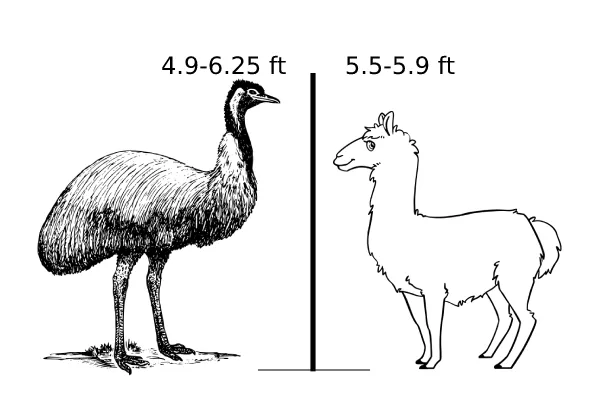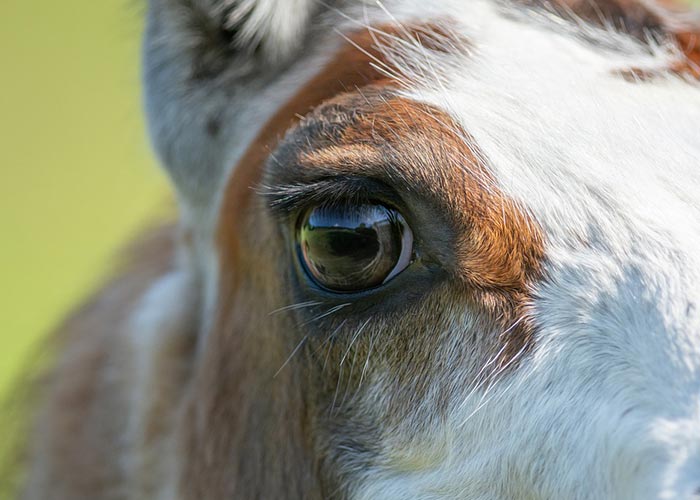Despite both being unique and interesting animals, llamas and emus are quite different from one another. Llamas are domesticated South American camelids, while emus are flightless birds native to Australia.
In this article, we will compare and contrast the two species and see who would win in a llama vs emu fight.
Table of Contents
Comparing Llamas And Emus
| Llama | Emu | |
| Size | – Height: 5.5-5.9 ft – Weight: 287-600 lb – Length: 3-5 ft | – Height: 4.9-6.25 ft – Weight: 40-132 lb – Length: 4.6-5.4 ft |
| Speed | – up to 40 mph | – up to 31 mph |
| Teeth, Claws, And Bite Force | – 200-300 PSI – 2 nails on each leg – 32 teeth | – n/a – 3 claws on each leg – No teeth |
| Senses | – Excellent hearing – Excellent sense of smell – Great eyesight | – Excellent eyesight – Very keen hearing – Decent sense of smell |
| Defensive Adaptations | – Thick fur and skin – Size and weight – Spitting – Running away | – Thick skin and fur – Size – Strong legs for jumping and running away – Mimicking rattlesnake sounds with tail – Loud hissing |
| Offensive Powers | – Strong kicks – Powerful bites – Charging – Spitting | – Strong kicks – Powerful bites – Sharp claws |
| Aggression Levels | – Moderate | – Moderate |
Llama Vs Emu – Size

When it comes to height, emus are slightly taller than llamas.
Adult llamas stand 5.5-5.9 feet tall while adult emus reach 4.9-6.25 feet in height.
Out of the 4 South American camelids (llamas, alpacas, vicunas, and guanacos), llamas are the largest while the emus are the second tallest birds in the world (after ostriches). Both animals have extremely long necks: the ones of llamas measure 1.7-2.25 feet long!
When it comes to weight, llamas are significantly heavier than emus.
Adult llamas can weigh between 287 and 600 pounds while the largest emus reach between 40 and 132 pounds.
Finally, when it comes to body length, emus have a slight advantage.
These birds can reach 4.6-5.4 feet from beak to tail with llamas measuring from 3 to 5 feet in length.
Llama Vs Emu – Speed

If they were to race, a llama would win against an emu by a slight margin.
Despite not having the longest legs, llamas are still fast runners. Relying on speed to run away from danger, llamas can reach a top speed of 40 mph (65 km/h). Emus, on the other hand, have strong and long legs to run away from predators and cross great distances. Emus’ top speed is 31 mph (50 km/h).
Both animals also know how to swim. Although their swimming speeds have not yet been measured, some experts speculate that emus are stronger swimmers than llamas as they have longer legs and feathers that are more waterproof than llamas’ thick and colorful fur that would slow them down.
Fun Fact: Emus are the only birds with calf muscles!
Llama Vs Emu – Teeth And Claws

Unlike emus who have no teeth, llamas have 4 fighting teeth on the upper and 2 on the lower jaw. Their total teeth number is 32 and an estimated bite force is 200-300 PSI (pounds per square inch).
Their modified canine and incisor teeth are very sharp and can cause serious injuries. Some adult males might also use their razor-sharp teeth to castrate other males and reduce competition. Yes, you read it right!
Emus, on the other hand, have 3 sharp claws on each of their toes; the toe and claw are around 6 inches long. Llamas do not have claws but 2 nails on the end of each toe that might cause some lacerations.
Llama Vs Emu – Senses

Emus and llamas have well-developed senses they use to find food, notice danger, and protect themselves.
Emus have good eyesight and hearing, which they use to detect danger at a distance or find food. These large birds also have big eyes that are almost 2 inches wide (larger than their brains) which allow them to see color.
Llamas have an excellent sense of smell, eyesight, and hearing. They have long, banana-shaped ears they use to hear sounds and communicate with others. Their large eyes are set at the sides of the skull; this provides excellent peripheral vision with a broad field of view to the animals. Excellent eyesight and keen vision allow llamas to notice movements in the distance easily.
Llama Vs Emu – Defensive Adaptations

Both emus and llamas have unique adaptations that help them survive the harsh conditions they live in and protect themselves from danger.
To keep them safe from predators, llamas have thick wool and skin. The skin on their neck region can be as thick as 0.4 inches; their jugular vein is nestled deep into the body of the neck to prevent neck bites from punctuating the vein.
Lama wool is between 20 and 40 microns in diameter and hollow in the middle. This makes it significantly warmer than other animals’ fur and helps them stay warm when the temperature is low and prevents dangerous UV rays from reaching the skin.
Ultimately, llamas can use their speed to dart away from danger and avoid getting hurt by a dangerous predator.
When confronted with danger, emus will use their strong and muscular legs to leap into the air and protect their heads and necks from the incoming attack. Their main predators, dingos, can reach speeds from 30-40 mph, which gives emus a decent chance to outrun them if they spot them on time.
Their thick skin and fluffy fur might reduce the bite impact; emus are also known to make themselves bigger by puffing their chests/necks, making loud hisses, or even mimicking rattlesnake sounds with their tails.
Llama Vs Emu – Offensive Adaptations

Despite not having sharp claws and strong legs, llamas are better equipped to fight than emus.
Each year, there are around 100 reported emu attacks in Australia, with these animals causing scratches, bruises, and minor abrasions to people. Using their powerful legs, they will kick forward or jump in the air to try to cut their enemy with their sharp claws.
Although emus have beaks, they will rarely try to peck predators, as it would leave their necks exposed. They also have a small claw at the end of each wing which might also cause some damage.
Llamas’ main offensive weapons are their strong kicks, powerful bites, and neck wrestles. By the time they become sexually mature, males will have developed 6 fighting teeth, two upper and one lower set. These sharp and dangerous canines can do a lot of damage and give them an advantage over emus.
Llama Vs Emu – Aggression

Similar to other animals when feeling threatened, llamas and emus can be very aggressive and dangerous.
Llamas are, generally speaking, temperate, confident, and intelligent creatures that usually do not bite. They might occasionally get into fights with other llamas or humans, especially if they develop Berserk Llama Syndrome (BLS).
However, because of their slightly more aggressive nature, people will train llamas to be their guard animals. These guard llamas will protect livestock at night, attacking, biting, kicking, chasing away, and sometimes killing predators like foxes or coyotes.
Despite being powerful birds, generally speaking, emus are not very aggressive. They can become if they feel other animals threaten them, their young, or their eggs. They turn aggressive during the breeding season, with females often fighting for access to males. Emus can also panic easily and might hurt you with their legs and claws.
Llama And Emu As Guard Animals

For many years, farm owners have switched to using emus, llamas, and other animals to protect their livestock from different predators.
Llamas are natural herd protectors with a seemingly personal vendetta against the coyotes. If they get into contact with one, they will sound an alarm, try to chase away the invasive predator, or try to stomp it.
Emus can be also very territorial and potentially aggressive when it comes to this matter; these birds are very smart and will sense when another animal enters their space that shouldn’t be there. Using their sharp, strong feet, these guard animals will claw coyotes to drive them away, keeping your property and livestock safe.
Some farmers suggest that instead of using a dog, you should get an emu, a llama, or/and a donkey.
Who Would Win In A Fight Between A Llama And An Emu?
Despite having a slight disadvantage in height, a llama would win a fight against an emu. Llama weighs almost 5 times more than an emu and has razor-sharp canine teeth that can be lethal.
An emu might try to kick and scratch but a llama would just charge at the bird, neck wrestle and push it to the ground, and win in this duel. An emu would definitely put up a fight but the llama’s better offensive weapons and bigger size (weight) would be too much for an emu to handle.